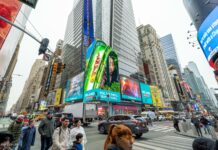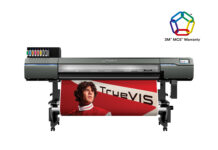“The phrase ‘soft signage’ refers to any sign or visual display executed with fabric,” explains Fernando Catania, product manager at Roland DGA Corporation (www.rolanddga.com) in Irvine, California.
After a few engine-warming laps, soft signage is racing ahead with new technology—turbo-charging the niche in materials and applications. “The choices in textures and types of textiles offers signage customers a richer array in substrates,” says Michael Labella, product manager for U.S. Sublimation, Inc. (www.ussublimation.com) in Fort Lauderdale, Florida. “Shops today have become more digital print shops than sign shops.”
Soft signage encompasses products such as polyester textiles, canvas, flag materials, self-adhesive vinyl, PVC banner, backlit films, fabrics, PVC mesh, and more. It’s also taking off in a variety of applications. “Tradeshow graphics is the largest sector in textile printing,” states Paul Person, a partner with Display Graphic Systems (www.displaygraphicsystems.com)
in Elizabeth, Illinois. “Especially in the last seven to ten years—with the advent of dye-sublimation for the inkjet—it’s exploded in tradeshow graphics. What’s happened with the direct disperse inkjet printing is that it’s opened up to whoever wants to get into it.”
Stitching Together Jobs
“In terms of scale, fabrics don’t lend themselves well to very fine details such as small text; instead they’re better suited for big, bold statements,” says Catania. “Because of this, they’re excellent for soffits, organic shapes, large hanging structures, banners, flags, and even building wraps.”
For example, Advanced Digital Textiles, LLC (www.advdigitaltextiles.com), a printing service provider in Monroe, North Carolina, recently produced a large stage display for the National Association of Stock Car Auto Racing. “We collaborated with Luxury Tec to produce a 100 percent fabric mobile media,” comments Nick Del Verme, vice president of Advanced Digital Textiles.
To keep digital printing schedules full, says Labella, sign makers might consider jobs from seemingly unlikely places: the local quilting club, fabric designers, wall coverings, and upholstery. “That’s the real opportunity for a lot of sign shops to make their business grow—to take them into a different path,” he says. “Some customers in the sign business started looking for other markets and found them. They started printing golf bags and flags for golf courses and then added more products. You do have more options with fabric than with vinyl. Venture outside the current comfort zone.”
Labella cites the recent example of a sign shop customer who asked for roll-to-roll textile printing. “The sign shop owner prints rolls of fabric—that’s his business. The sign shop owner is doing things that have nothing to do with the sign business,” he remarks. “There’s no textile production done in the United States anymore. We had a customer that did a whole run of mattress covers. Before you’d have to go to China and order 10,000 yards.”
Another example of a unique job opportunity is with table covers, which are very popular for tradeshows, local hotels, and weddings. “The possibilities are endless with fabrics,” says Labella.
Inking Out Possibilities
New, more effective, and greener inks are also increasing the possibilities for new signage applications in textiles. “The industry is now developing inks that will adhere to many other substrates,” states Steve Benedict, east coast channel manager for Graphics One, LLC (GO) (www.graphicsone.com) in Burbank, California. “Signage has now transitioned into a new era of textile printing: upholstery, static-cling, acrylics, foam-core—that’s where the industry is going.”
An example of a new ink is GO’s SEPIAX, a water-based, weather-resistant ink that will adhere to any substrate (including tissue, glass, wood, and cotton). The ink is “totally green” and will work in any Epson-based piezo printhead. According to Benedict, conversion to the new ink costs from a “few hundred to a few thousand” dollars, depending on the existing printer.
MxF ink from Sawgrass Technologies (www.sawgrassink.com) in Mount Pleasant, South Carolina is another newly developed ink. Unlike acid dyes, this environmentally friendly, water-based ink requires no post-print steaming or washing.
“MxF opens a whole new world of opportunity for the flag and banner industry,” says Peter Valinski, sales director for the Sawgrass Industrial Division. “The only downside is speed. Digital printers just don’t produce like conventional printers.”
Getting Equipped
Equipment costs are also a consideration. “If you’re a novice to dye-sublimation, then direct-to-fabric printing is probably the way to go because of the much-higher cost of dye-sublimation printing,” suggests Person. “Now that they’re mass producing, it’ll come down. But that just gets you the printing—not finishing. It’s still not a cheap startup. Think very long and hard before you venture into it.”
Labella also warns sign makers about the temptation to cut corners when getting into dye-sublimation. “The tools you use are crucial: The right ink, the right heat press, etc.,” he says.
Labella says direct-to-textile printing may eliminate the paper, but you still need very even heat distribution. “They need to look inside the curing units of these systems they’re buying. Some of these units want to have the element on the bottom. Some have decided to put the heating element on the back of the machine,” he states. “Over time, you’ll start getting cold spots. Heat tries to go up—fabric wants the heat to go forward to properly cure. You need to look under the hood to see if they’ve properly designed it for even heat distribution.”
Joe Balabuszko, regional sales manager for Earl Mich Company (www.earlmich.com) in Wood Dale, Illinois, also has some advice for those looking to add equipment to their shop. “Read your customer base,” he says. “The small- to medium-sized sign companies should start by adding T-shirts, banners, and community activity stuff. It’s more of a natural sell.”
For shops considering an expansion into textile signage, Del Verme advises sticking to the fundamentals in order to have a successful product. “Our focus on quality is being able to control all the variables. The only thing I need to complete the job is the fabric,” he comments.
Del Verme adds that sign shops should also consider the quality of the pre-treatment and finishing processes, even if those are jobbed out; it’s particularly important in direct-to-fabric printing. “Sign shops should also demand ink suppliers give the same batch-to-batch consistency in ink,” he remarks.
Labella agrees. “There are finishing solutions using adhesives that will withstand most outdoor environments for one month up to three months,” he says.
Quality issues don’t rise to the forefront “when you’re producing one 3-by-5-foot sign at a time on a $16,000 machine,” points out Del Verme. “But [if] you’re not set up for anything more, then you’ll have issues if you try and run fifty.”
Advantages
Labella has observed that many sign shops don’t fully grasp the concept that textiles offer an opportunity for product expansion. “‘What do you do with it?’ they’ll ask. ‘I don’t get a lot of demand for it,’ they’ll counter,” says Labella. “There’s a bit of disconnect there. They don’t understand that this is an additional substrate they can offer to market a production they already have.”
So just what are the advantages of offering textiles? “Soft signage will typically save on freight costs, due to the lighter weight of fabrics versus rigid signage,” answers John Evans, vice president of Sales, Graphics Media, with Herculite Products, Inc. (www.herculite.com), in Emigsville, Pennsylvania. “Another advantage is that many fabrics can be folded for convenient packaging. This comes in handy for tradeshows and other events, and the appearance of soft signage is also warm and visually appealing to consumers. Lastly many of the soft signage fabrics suppliers are now offering ‘green’ or recyclable fabric options.”
And going green has its own benefits. “It’s a free way to market the fact that we’re being environmentally friendly,” says Del Verme. “We’re in that transition period where it costs money to be very green, but with fabric signage, you can be green and save money too.”
Another advantage is the seemingly endless amount of applications textiles can be used for. “Textiles have such a huge variety of finishings/textures, and it gives them an unlimited amount of options—from low-cost mesh to high-end fabrics. Hotels and churches love plush fabrics,” states Labella. “If you put [a design] on a plush fabric, it gives it a completely different look. Some clientele that they’re serving don’t know there’s a better option for them.”
There’s a lot of possibility, but very few shops are taking advantage of it. “Sign shops don’t understand. Textiles are a renewed source of revenue. With vinyl, the margin is low. Textiles have good profit margins and less competition,” says LaBella. “Now is the time to get into it. It’s $11 to $12 per square foot output compared to $3 to $5 per square foot for vinyl. Even though the cost of the fabric and ink is slightly higher, the cost of ink is actually lower in dye-sublimation. In the end, cost per square foot is very comparable.”
Sign shops should be aware that textiles aren’t ideal for everything however. For example, textile printing processes don’t work well with shiny fabrics, which tend to wrinkle and distort the typography. However the advantages outweigh the disadvantages in the end.
Evans says, before getting started, it’s important to gather as much information about the types of fabrics that are currently available and then pick several that may fit your market. “Ask for printing input from a few of the equipment manufacturers and ask that they test-print some of the fabrics that you’ve chosen,” he advises. b










